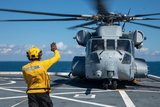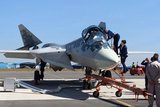Iraqi Air Force adds four new Mi-17s
CAMP TAJI - The Iraqi Air Force (IAF) received four new MI17 helicopters Oct. 31, adding to its fleet of more than 50 rotary wing aircraft throughout the country.
The IAF has begun beefing-up its fleet of Huey and MI17 helicopters; in the past eight months, the IAF has grown in capabilities, starting with just one helicopter.
Airmen from the IAF have been training with U.S. Air Force Airmen from the 770th Air Expeditionary Advisor Squadron, Coalition Air Force Transition Team, Multi-National Division - Baghdad.
"We are teaching them flying, door gunning, maintenance and loading the weapons systems," said Air Force Master Sgt. Warren McCullough, from Harrison, Ark., who serves as the flight safety and squadron first sergeant. "The school house we have here on Camp Taji teaches the Iraqis basic English, multiple aviation occupational specialties and hands on training over here on the airfield."
The Airmen from Eglin Air Force Base, based in Florida, are on a one-year tour teaching the Iraqi Airmen how to perform full-spectrum aviation operations. The school classifies the Iraqis in three skill categories - level-three, level-five and level-seven.
Level-three is a new Iraqi Airman who requires supervision while performing his duties. A level-five airman is similar to a non-commissioned officer or junior officer in the U.S. Air Force, who can perform duties with little or no supervision. Level-seven are supervisors, such as senior NCOs or senior officers, who are capable of performing duties with no supervision. Level-seven requires years of schooling and experience. The majority of Iraqi airmen at the school are level-three and level-five trainees.
"These [new helicopters] will help us tremendously," said IAF Col. Salam Hassan, commander of Squad 15 on Camp Taji. "They will support the special forces through transporting and in the future combat operations when we have completed our training.
"The Americans help with everything, to include training and operations," said the jubilant Iraqi colonel on the camp north of Baghdad. "I think the training is very good, and the American pilots have a lot of experience."
Although much smaller, the MI17 helicopters are compared much to the American CH-47F Chinook helicopters in terms of how they are used. They are Russian-made and are used for transporting personal and equipment, and combat operations, such as air assaults and air insertion missions.
Currently, the aircraft are being used by the United Nations, the Czech Air Force, the Royal Thai Army, Saudi Arabia and Russia.
"Our job is to train and advice this counter-terrorism squadron," said Lt. Col. William Rowell, director of operations. "We expect 22 more MI17 helicopters by the end of the year. By 2010, their fleet will grow substantially."
(By Sgt. 1st Class Brent Hunt, 4th Infantry Division)
Source: Official website of Operation Iraqi Freedom
More from Defence Helicopter
-
![Germany to send WS-61 Westland Sea King helicopters to Ukraine]()
Germany to send WS-61 Westland Sea King helicopters to Ukraine
Germany has committed to sending Ukraine six of its 21 retiring WS-61 Westland Sea King multirole, amphibious helicopters.
-
![Boeing secures $271 million to advance modernisation of US Special Operations' MH-47G Chinook]()
Boeing secures $271 million to advance modernisation of US Special Operations' MH-47G Chinook
Boeing has clinched a major contract modification to further its backing of the US Special Operations Command’s MH-47G Chinook aircraft modernisation effort.
-
![Dubai Airshow 2023: South Korean homegrown helicopters make international debut]()
Dubai Airshow 2023: South Korean homegrown helicopters make international debut
Two KAI helicopters, the KUH-1E utility helicopter and the Light Attack Helicopter (LAH), have taken centre stage at the Dubai Airshow 2023.
-
![Italian Navy receives final NH90 helicopter]()
Italian Navy receives final NH90 helicopter
The Italian Navy now boasts a fleet of 56 NH90 helicopters comprising 46 SH-90As and 10 MH-90As.
-
![Argentina seeks AW109 and CH-46 Sea Knight helicopters]()
Argentina seeks AW109 and CH-46 Sea Knight helicopters
The Argentinian Air Force (FAA) and the Argentinian Naval Aviation Command (COAN) are looking for options to upgrade their helicopter fleets.
-
![DSEI 2023: Lockheed to produce about 40% of Black Hawks on UK soil if it wins NMH contest]()
DSEI 2023: Lockheed to produce about 40% of Black Hawks on UK soil if it wins NMH contest
Lockheed Martin promises a boost to the British job market and export opportunities, while strengthening ties with Poland and positioning the UK for a future in rotorcraft technology in the event of a New Medium Helicopter competition triumph.

























